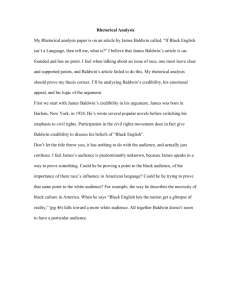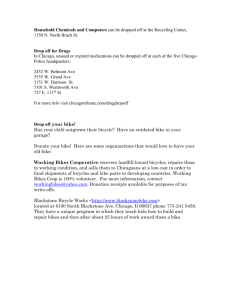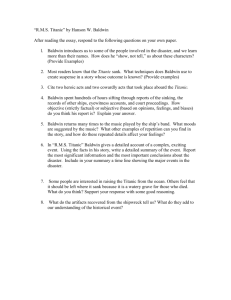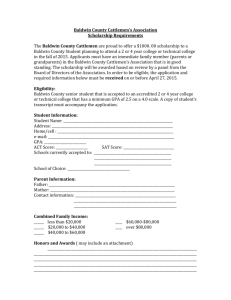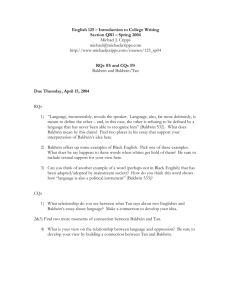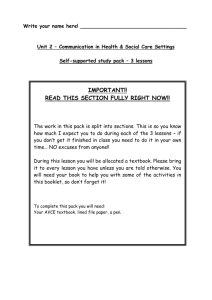Baldwin Bicycle Company*
advertisement
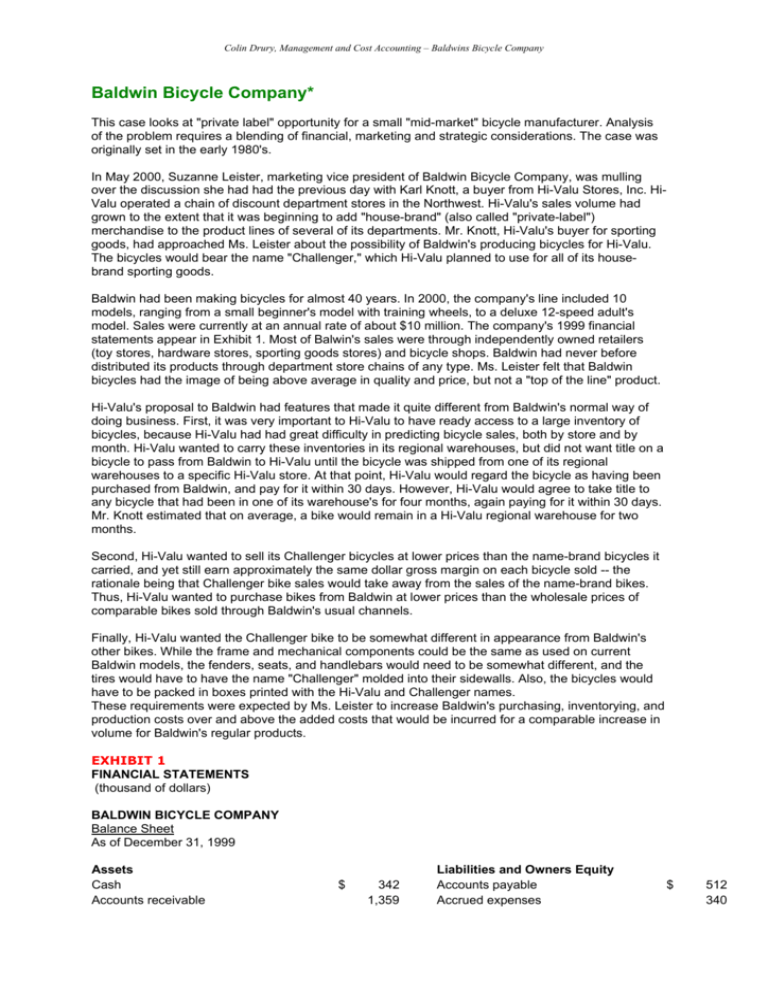
Colin Drury, Management and Cost Accounting – Baldwins Bicycle Company Baldwin Bicycle Company* This case looks at "private label" opportunity for a small "mid-market" bicycle manufacturer. Analysis of the problem requires a blending of financial, marketing and strategic considerations. The case was originally set in the early 1980's. In May 2000, Suzanne Leister, marketing vice president of Baldwin Bicycle Company, was mulling over the discussion she had had the previous day with Karl Knott, a buyer from Hi-Valu Stores, Inc. HiValu operated a chain of discount department stores in the Northwest. Hi-Valu's sales volume had grown to the extent that it was beginning to add "house-brand" (also called "private-label") merchandise to the product lines of several of its departments. Mr. Knott, Hi-Valu's buyer for sporting goods, had approached Ms. Leister about the possibility of Baldwin's producing bicycles for Hi-Valu. The bicycles would bear the name "Challenger," which Hi-Valu planned to use for all of its housebrand sporting goods. Baldwin had been making bicycles for almost 40 years. In 2000, the company's line included 10 models, ranging from a small beginner's model with training wheels, to a deluxe 12-speed adult's model. Sales were currently at an annual rate of about $10 million. The company's 1999 financial statements appear in Exhibit 1. Most of Balwin's sales were through independently owned retailers (toy stores, hardware stores, sporting goods stores) and bicycle shops. Baldwin had never before distributed its products through department store chains of any type. Ms. Leister felt that Baldwin bicycles had the image of being above average in quality and price, but not a "top of the line" product. Hi-Valu's proposal to Baldwin had features that made it quite different from Baldwin's normal way of doing business. First, it was very important to Hi-Valu to have ready access to a large inventory of bicycles, because Hi-Valu had had great difficulty in predicting bicycle sales, both by store and by month. Hi-Valu wanted to carry these inventories in its regional warehouses, but did not want title on a bicycle to pass from Baldwin to Hi-Valu until the bicycle was shipped from one of its regional warehouses to a specific Hi-Valu store. At that point, Hi-Valu would regard the bicycle as having been purchased from Baldwin, and pay for it within 30 days. However, Hi-Valu would agree to take title to any bicycle that had been in one of its warehouse's for four months, again paying for it within 30 days. Mr. Knott estimated that on average, a bike would remain in a Hi-Valu regional warehouse for two months. Second, Hi-Valu wanted to sell its Challenger bicycles at lower prices than the name-brand bicycles it carried, and yet still earn approximately the same dollar gross margin on each bicycle sold -- the rationale being that Challenger bike sales would take away from the sales of the name-brand bikes. Thus, Hi-Valu wanted to purchase bikes from Baldwin at lower prices than the wholesale prices of comparable bikes sold through Baldwin's usual channels. Finally, Hi-Valu wanted the Challenger bike to be somewhat different in appearance from Baldwin's other bikes. While the frame and mechanical components could be the same as used on current Baldwin models, the fenders, seats, and handlebars would need to be somewhat different, and the tires would have to have the name "Challenger" molded into their sidewalls. Also, the bicycles would have to be packed in boxes printed with the Hi-Valu and Challenger names. These requirements were expected by Ms. Leister to increase Baldwin's purchasing, inventorying, and production costs over and above the added costs that would be incurred for a comparable increase in volume for Baldwin's regular products. EXHIBIT 1 FINANCIAL STATEMENTS (thousand of dollars) BALDWIN BICYCLE COMPANY Balance Sheet As of December 31, 1999 Assets Cash Accounts receivable $ 342 1,359 Liabilities and Owners Equity Accounts payable Accrued expenses $ 512 340 Colin Drury, Management and Cost Accounting – Baldwins Bicycle Company Inventories Plant and equipment (net) 2,756 3,635 $ Short-term bank loans Long-term Note payable Total liabilities Owner's equity 8,092 $ Income Statement For the Year Ended December 31, 1999 Sales revenues $ 10,872 Cost of Goods Sold 8,045 Gross margin 2,827 Selling and Administrative expenses 2,354 Income before taxes 473 Income tax expense 218 Net income $ 255 On the positive side, Ms. Leister was acutely aware that the "bicycle boom" had flattened out, and this plus a poor economy had caused Balwin's sales volume to fall the past two years.* As a result, Baldwin currently was operating its plant at about 75 percent of one-shift capacity. Thus, the added volume from Hi-Valu's purchases could possibly be very attractive. If agreement could be reached on prices, Hi-Valu would sign a contract guaranteeing to Baldwin that Hi-Valu would buy its house-brand bicycles only from Baldwin for a three-year period. The contract would then be automatically extended on a year-to-year basis, unless one party gave the other at least three-months' notice that it did not wish to extend the contract. Suzanne Leister realized she needed to do some preliminary financial analysis of this proposal before having any further discussions with Karl Knott. She had written on a pad the information she had gathered to use in her initial analysis; this information is shown in Exhibit 2. * Note: The American bicycle industry had become very volatile in recent years. From 1984 through 1987 sales average about 7 million units a year. By 1990 the total was up to a record 15 million units. By 1992 volume was back down to 7.5 million units. By 1999 volume was back up to 10 million units, still well below the peak years. EXHIBIT 2 DATA PERTINENT TO HI-VALU PROPOSAL (Notes taken by Suzanne Leister) 1. Estimated first-year costs of producing Challenger bicycles (average unit costs, assuming a constant mix of models): Materials $39.80 * Labor 19.60 Overhead (@125% of labor ) 24.50 ** $83.90 * Includes items specific to models for Hi-Valu, not used in our standard models. ** Accountant says about 40 percent of total production overhead is variable; 125 percent of DL$ rate is based on volume of 100,000 bicycles per year. 2,626 1,512 4,990 3,102 8,092 Colin Drury, Management and Cost Accounting – Baldwins Bicycle Company 2. One-time added costs of preparing drawings and arranging sources for fenders, seats, handlebars, tires, and shipping boxes that differ from those used in our standard models: approximately $5,000. 3. Unit price and annual volume: Hi-Valu estimates it will need 25,000 bikes a year and proposes to pay us (based on the assumed mix of models) an average of $92.29 per bike for the first year. Contract to contain an inflation escalation clause such that price will increase in proportion to inflation-caused increases in costs shown in items above; thus, the £92.29 and $83.90 figures are, in effect, "constant dollar" amounts. Knott intimated that there was very little, if any, negotiating leeway in the $92.29 proposed initial price. 4. Asset-related costs (annual variable costs, as percent of dollar value assets) Pretax cost of funds (to finance receivables or inventories) Record keeping costs (for receivables or inventories) Inventory insurance State property tax on inventory Inventory-handling labor and equipment Pilferage, obsolescence, breakage, etc. 18.0% 1.0 0.3 0.7 3.0 0.5 5. Assumptions for Challenger-related added inventories (average over the year): 6. Materials: two months' supply. Work in process: 1,000 bikes, half completed (but all materials for them issued). Finished goods: 500 bikes (awaiting next carload lot shipment to a Hi-Valu warehouse). 7. Impact on our regular sales: Some customers comparison shop for bikes, and many of them are likely to recognize a Challenger bike as good value when compared with a similar bike (either ours or a competitor's) at a higher price in a nonchain toy or bicycle store. In 1999, we sold 98,791 bikes. My best guess is that our sales over the next three years will be about 100,000 bikes a year if we forego the Hi-Valu deal. If we accept it, I think we'll lose about 3,00 units or our regular sales volume a year, since our retail distribution is quite strong in Hi-Valu's market regions. These estimates do not include the possibility that a few of our current dealers might drop our line if they find out we're making bikes for Hi-Valu. Note: The information about overhead in item 1 above in Exhibit 2 can be used to infer that fixed manufacturing overhead is about $1.5 million per year. ASSIGNMENT QUESTIONS 1. What is the "relevant" cost of manufacturing a Challenger bike? 2. What is the "relevant" cost (on a per bicycle basis) of carrying the working capital investment involved in the Challenger deal? 3. Should the Challenger deal be charged for the lost sales of bikes through the regular distribution channel ("erosion" or "cannibalization" cost)? If so, what is the "relevant" erosion charge? 4. Can you estimate the incremental return on investment for the Challenger deal? 5. What are the major cash flow implications of the Challenger deal? 6. How would you describe Baldwin's financial situation at the end of 1999? 7. How would you describe Baldwin's strategic position at he end of 1999? Is the Challenger deal a good strategic fit for Baldwin? Colin Drury, Management and Cost Accounting – Baldwins Bicycle Company * R.N.Anthony and J.S. Reece, Accounting: Test and Cases, Homewood, Ill.: Richard Irwin, Inc., 1983, pp. 742-744. Reproduced by kind permission of the authors.
